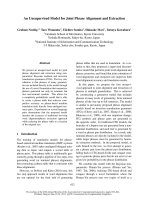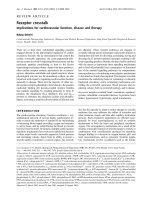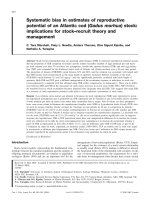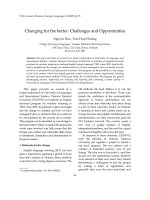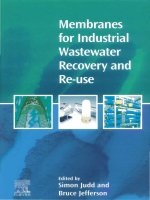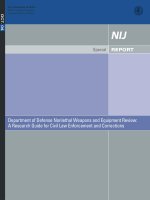Membranes for Industrial Wastewater Recovery and Re-use ppt
Bạn đang xem bản rút gọn của tài liệu. Xem và tải ngay bản đầy đủ của tài liệu tại đây (8.42 MB, 318 trang )
Membranes
for
Industrial
Membranes for Industrial
Wastewater Recovery and Re-use
To
Claire, Oliver and Samuel
Membranes for Industrial
Wastewater Recovery and Re-use
Edited
by:
Simon
Judd and
Bruce Jefferson
E
L
S
E
1-
1
i5
R
UK
USA
JAPAN
Elsevier Science Ltd, The Boulevard, Langford Lane, Kidlington, Oxford
OX5
lGB,
UK
Elsevier Science Inc, 360 Park Avenue South, New York,
NY
Elsevier Japan, Tsunashima Building Annex, 3-20-12 Yushima,
Bunkyo-ku, Tokyo 113, Japan
10010-1710, USA
Copyright
0
2003 Elsevier Ltd.
All rights reserved. No part of this publication may be reproduced, stored in
a retrieval system or transmitted in any form
or
by any means: electronic,
electrostatic, magnetic tape, mechanical, photocopying, recording
or
otherwise, without prior permission in writing from the publishers.
British Library Cataloguing
in
Publication
Data
Membranes for industrial wastewater recovery and re-use
1
.Water reuse 2.Membranes (Technology) 3.Water
-
Purification
-
Reverse osmosis process
I. Judd, Simon
628.1'674
ISBN 1856173895
Library
of
Congress Cataloging-in-Publication Data
Judd, Simon
11. Jefferson, Bruce
Membranes for industrial wastewater recovery and re-use
/
Simon
Judd and Bruce Jefferson.
Includes bibliographical references and index.
1.
Sewage-Purification.
2.
Factory and trade waste-Purification.
3. Membranes (Technology) 4. Water reuse.
I.
Jefferson, Bruce.
11. Title.
p. cm.
ISBN 1-8561 7-389-5
TD754.J83 2003
62 8.3'5241~2
1
2003040757
No
responsibility is assumed by the Publisher for any injury and/or damage
to persons
or
property as a matter of products liability, negligence or
otherwise, or from any use or operation of any methods, products,
instructions
or
ideas contained in the material herein.
Published by
Elsevier Advanced Technology, The Boulevard, Langford Lane, Kidlington
Oxford OX5
lGB,
UK
Tel.: +44(0) 1865 843000
Fax: +44(0) 1865 843971
Typeset by Variorum Publishing Ltd, Lancaster and Rugby
Printed and bound in Great Britain by Biddles Ltd, Guildford and King's
Lynn
Contents
Preface
Contributors
Chapter
1
Introduction
1.1
1.2
Industrial water
1.3
Membrane technology
1.
I
Water reuse motivations and barriers
Chapter
2
Membrane technology
2.1
2.2
2.3
2.4
The membrane
2.
I.
1
2.
I
.2
Membrane structure
2.
I.
3
2.1.4
Membrane configurations
The process fundamentals
2.2.1
Process performance definitions
2.2.2
The driving force
2.2.3
2.2.4
Critical flux
The theory
2.3.1
Membrane mass transfer control
2.3.2
Process design and operation
2.4.1
Staging
2.4.2
Specific energy demand
2.4.3
Fouling and pretreatment
2.4.4
Backwashing and cleaning
References
Membrane and membrane process definition
Membrane materials and their manufacture
Factors opposing the driving force
Fouling/cake layer mass transfer control
ix
xiii
2
4
7
14
14
14
17
23
32
32
34
34
39
40
41
43
52
52
55
59
66
70
vi
Membranes
for
Industrial Wastewutrr Recovery and
Re-use
Chapter
3
Industrial waters
3.1
3.2
3.3
3.4
3.5
The power industry: water requirements for power
generation and cooling water
3.1.1 Water demand by the power industry
3.1.2 Overview ofcooling water systems
3.1.3 Overview of boiler feedwater systems
3.1.4 Sources of water used for
3.1.5 Water quality comparisons
3.1.6 Optimisation of water use in recirculating
cooling systems
3.1.7 Cooling tower water quality issues
3.1.8 Governing legislation and guidelines
3.1.9 Volumes and quality of aqueous process
waste streams
3.1.10 Current reuse practices and opportunities
References
The pulp and paper industry
3.2.1 Introduction
3.2.2
3.2.3 Effluent volumes and quality
3.2.4
3.2.5
3.2.6 Conclusions
Acknowledgements
References
The textile industry
3.3.1 Categories of textile processing operations
3.3.2 Effluents from textile processing unit
operations
3.3.3 Process water quality requirements
3.3.4 Legislation
3.3.5 Conventional treatment
3.3.6 Demand management
3.3.7 Reuse practice and opportunities
References
The beverage industry
3.4.1 Point of use recycling opportunities
3.4.2 End
of
pipe recovery opportunities
References
Pure waters in the pharmaceutical industry
3.5.1
Background
3.5.2 Water quality standards
3.5.3
3.5.4 Reuse opportunities
Pulping and paper manufacturing processes
Current water and effluent purification
systems and governing legislation
Membranes in the pulp and paper industry
Volumes and quality of aqueous process
and waste streams
76
76
77
80
80
81
85
88
93
94
95
100
102
102
104
106
113
115
125
125
125
132
132
133
143
144
146
148
149
154
159
159
160
163
163
163
164
167
169
Contents
vii
Chapter
4
System design aids
4.1 Computer-aided design for reverse osmosis plant
4.1.1 Introduction
4.1.2
4.1.3
RO
design software
4.1.4 Cost calculation
4.1.5 Overview
References
4.2.1 Introduction
4.2.2 Water pinch: the history
4.2.3 Methodology
4.2.4 Computed solutions
4.2.5 Software tools currently available
4.2.6
4.2.7 Conclusion
References
4.3 Design examples
4.3.1
4.3.2
4.3.3
4.3.4
4.3.5
Key elements
of
the reverse osmosis process
4.2 Water pinch analysis
Case study: water pinch and implementation
of
regeneration techniques
Problem in reverse osmosis: film theory and
energy demand
Problem in reverse osmosis: array design
Problem in reverse osmosis:
CAD
array design
Problem in electrodialysis: energy demand
Problem in submerged membrane filtration
design
Chapter
5
Case studies
5.1
5.2
5.3
5.4
Flag Fen high-purity water production plant
(UK)
5.1.1 Background
5.1.2 Description ofplant
5.1.3 Performance
Eraring Power Station: purification
of
secondary
sewage for boiler feedwater (Australia)
5.2.1 Background
5.2.2 Description ofplant
5.2.3 Performance
Doswell combined cycle power plant: zero liquid
discharge
(USA)
5.3.1 Background
5.3.2 Description of system
5.3.3 Performance
VHP Ugchelen: paper mill water recycling
(Netherlands)
5.4.1 Background
172
172
172
176
182
183
186
186
186
187
187
191
197
201
209
209
213
213
216
217
220
223
228
228
228
2
30
232
232
233
235
237
237
238
2
40
241
241
5.4.2 Description of system 242
viii
Membranes
for
Industrial Wastewater Recovery and
Re-use
5.5
5.6
5.7
5.8
5.9
5.4.3 Performance
Kronospan Ltd: medium-density fibreboard wash
water recycling
(UK)
5.5.1 Background
5.5.2 Description of plant
5.5.3 Performance
M-Real Kirkniemi paper mill (Finland)
5.6.1 Background
5.6.2 Description of plant
5.6.3 Performance
T.
Forsell and Son: dyewaste water recycling plant
(UK)
5.7.1 Background
5.7.2 Description ofplant
5.7.3 Performance
N
food plant wastewater treatment and recycling
plant (Japan)
5.8.1 Background
5.8.2 Description ofplant
5.8.3 Performance
Pasfrost vegetable processing plant (Belgium)
5.9.1 Background
5.9.2 Description ofplant
5.9.3 Performance
5.10 Automotive water recycling (Germany)
5.10.1 Background
5.10.2 Plant description
5.10.3 Performance
NEC
Semiconductors: microelectronics wastewater
reclamation
(UK)
5.1 1.1 Background
5.1 1.2 Description of plant
5.1 1.3 Performance
5.1
1
5.12 Discussion
5.1 3 Reference material
Index
243
244
2 44
245
246
248
248
248
249
2 50
2 50
251
253
2 54
2 54
255
256
257
257
258
259
2 62
2 62
263
2 64
265
265
267
268
269
2 76
279
Preface
In setting out to produce a book on any given subject, the primary questions to be
answered are: "What should we write about?" and "Who's going to buy it?".
These questions are obviously interlinked.
The subject area of this book is well defined in the title: membrane technology
and
its
application to industrial water recycling. There can be little doubt
of
the
importance of recycling of water contaminated by industrial activity, and it is
hoped that the introduction to this book (Chapter
1)
sufficiently emphasises this
point. Stresses imposed on freshwater supplies continue to grow and
environmental legislation relating to discharges becomes ever more rigorous.
Given that technologies for water purification are tending to become more
efficient and generally cost-effective, it is inevitable that recovery and reuse
of
effluent will be more widespread in the future. It is also the case that membrane
processes play a pivotal role in many reclamation and reuse schemes in industry.
Their application across all industrial sectors has increased exponentially over
the last twenty years and there is little
sign
of
this growth abating.
Since the subject is very extensive the amount
of
detail is largely determined
by
the target readership, which relates to the second key question. This is rather
vexing matter, not least because potential readers are well served by a number
excellent texts on membrane processes and technologies (Table
1)
as well as a
growing number on water reclamation and reuse (Table
2).
Neither of these
tables is comprehensive, and it can always be argued that there is really nothing
new
to
write about.
So,
who might buy this book? What function is this book meant to serve?
Perhaps it is as well to outline what the book
is
not. The book is not meant to be a
comprehensive treatise on membrane processes and technologies, although an
outline of these areas is provided (Chapter
2)
with reference to membrane
materials, modules, and processes along with governing equations for use in
system design. For more comprehensive information than that provided the
interested reader may seek out such tomes as those produced by
Ho
and Sirkar,
Rautenbach and Albrecht, and Scott (Table
1).
Moreover, many of the industrial
process applications in which membranes find employment, such as the
biotechnology and food industries, are only briefly discussed with reference to a
x
Membranes
for
lndustrial Wastewater Recovery and Re-use
Table
1
Recent membrane textbooks
Author(s)/editor(s) Title Publisher Date
Nunes and Peinemann
Stephenson, Judd,
Jefferson and Brindle
Hillis
Radecki. Crittenden.
Shonnard and Bullock
Cheryan
Scott
Mallevialle, Odendaal
and Wiesner
Amjad
Ho and Sirkar
Membrane Technology in
the Chemical Industry
Membrane Bioreactors for
Wastewater Treatment
Membrane Technology in
Water and Wastewater
Treatment
Emerging Separation and
Separative Reaction
Technologies
for
Process
Waste Reduction
Ultrafiltration and
Microfiltration Handbook
Handbook
of
Industrial
Mcmhranes, 2nd edn
Water Treatment
Membrane Processes
Reverse Osmosis
Membrane Handbook,
2nd edn
Wiley-VCH 2001
IWA Publishing 2000
Royal Society
of
Chemistry
2000
American Institute ofchemical 1999
Engineers
Technomic 1998
Elsevier 1998
McGraw-Hill 1996
Van Nostrand Reinhold 1993
Van Nostrand Reinhold 1992
Table
2
Recent water recycling textbooks
Author/editor Title Publisher Date
Lens, Pol. Wilderer and Asano Water recycling and resource IWA publishing 2002
recovery in industry: analysis,
technology and implementation
Mann and Liu Industrial water reuse and McGraw-Hill 1999
wastewater minimization
Asano Wastewater reclamation Technomic 1998
and reuse
Rows and Ahdel-Magid Handbook of wastewater CRC
press
1995
reclamation and reuse
USGA Wastewater reuse for golf Lewis 1994
course irrigation publishers
few specific industrial sectors (Chapter
3).
Again, industrial process applications
are reasonably well documented in Cheryan (for filtration processes), Amjad
(reverse osmosis) and otherwise the general texts previously mentioned.
It is also the case that the book does not provide much detail of domestic or
municipal schemes, where water is either recycled within buildings or reclaimed
from municipal wastewater treatment plant and reused for extensive schemes
such as irrigation and aquifer recharge. There is also no discussion of
sustainability as a concept, or any
of
the related topics pertaining to
environmental impact and more holistic topics. Again, the interested reader is
Preface
xi
already very well served in such areas, and in particular extensive systems, by
the seminal work of Asano and the recent eclectic publication by Lens
et
al.
(Table 2). Finally, although the principles of water pinch analysis are described
in Section
4.2,
this is only to enable an understanding
of
how it can be used.
Once again, there are other texts available that comprehensively describe the
methodology and its derivation (Mann and Lui).
It is hoped by the editors, however, that anyone interested in industrial
wastewater recycling, including problem holders and membrane suppliers as
well
as
students and academics studying in this area, will find this book useful. In
particular, the book is meant to provide a practical aid to those readers with an
interest in actually selecting, installing and/or designing systems for recovering
and reusing industrial effluent.
To
his end, there
is
one chapter dedicated to
design (Chapter 4), and in particular computer-aided design, based on
commercial packages, of reverse osmosis arrays (Section
4.1)
and water
networks (Section 4.2). There are also eleven individual case studies, covering a
range
of
applications, which are discussed with reference to design and
operational facets of the water recycling treatment schemes (Chapter
5).
Whilst
not all industrial sectors where water recovery and reuse takes place are covered
in
this book (it is cxtremely difficult to extract all information pertaining
lo
industrial water quality, let alone water reuse) as much detailed as has been
made available is reported in the book. Lastly, the book is very much biased
towards engineering practice, rather than scientific study. Data pertaining to
membrane process performance in Chapters
3
and, more especially, Chapter
5,
are based almost entirely on existing pilot or full-scale systems, rather than
bench-scale studies or theoretical predictions.
As with any piece of work the editors would welcome any comments from
readers, critical or otherwise, and our contact details are included in the
following section.
The
editors
Simon judd
Dr Judd is a Reader in Water Sciences at Cranfield University with over
15
years'
experience
of
industrial and academic
R&D,
having spent three years in nuclear
waste management and two years in forensic science. In his current post he has
conducted research into a wide range
of
chemical and, principally, membrane
processes as applied to water and wastewater treatment. Topics have included
municipal and domestic wastewater treatment and reuse using membrane
bioreactors, nanofiltration of dye waste for water recovery and scale mitigation
in reverse osmosis for flux enhancement. He has contributed to and co-authored
a number
of
books
on both water recovery and reuse and membrane processes,
and has published extensively in peer-reviewed journals. Dr Judd also manages
swimming pool water treatment research activities, and chairs the Membrane
Academia Industry Network
(MAIN),
a
UK
research council-sponsored initiative
to encourage dissemination
of
information between the industrial and academic
communities in the
UK.
Contact:
Bruce
jefferson
Dr Jefferson is a Senior Research Fellow at the School
of
Water Sciences at
Cranfield University following graduation from the Department
of
Chemical
Engineering, Loughborough University. In his current post he has conducted
research into general physical and, more specifically, membrane processes for a
wide range of applications within both urban and industrial environments. He
has contributed to and co-authored a number
of
books
on
both water recovery
and reuse and membrane processes, and has published extensively in peer-
reviewed journals. Dr Jefferson has also presented papers at and chaired
numerous sessions on the subject
of
water recycling, and he is a member of the
IWA
specialist group committee on advanced treatment/membrane processes.
Contact:
xiv
Mrnibranrs for Industrial Wastrwnter
Recoverg
arid
Re-use
SJand
BJ.
The editors would like to covey their sincere thanks to the co-authors and
other contributors to this book, details ofwhom are given below.
The
co-authors
Danielle Baetens
Dr Baetens graduated in 1991 as a civil engineer in chemistry at the University
of Ghent, obtaining a PhD at the faculty of Agricultural Engineering, also in
Ghent, in
2000.
The PhD concerned modelling
of
biological phosphorus removal
in wastewater. Between 1991 and 1998 Dr Baetens worked at the University of
Ghent as assistant at the faculty of civil engineering on the treatment
of
air
pollution and wastewater treatment. Since 1999 she has worked at
Vito
(Flemish Institute for Technological Research), where she project is co-ordinator
of
the project group on process optimisation.
Contact:
€tieme
Brauns
Etienne Brauns graduated as a Metallurgical Civil Engineer at
KU
Leuven in
Belgium in 1976. He thereafter stayed at
KU
Leuven to contribute as a
researcher to a program on shape memory alloys, joining the Belgian national
nuclear research centre SCK-CEN in 1985. In 1990 all non-nuclear research at
SCK-CEN was transferred to Vito, founded in that year by the Flemish
government. As a researcher at Vito he originally continued R&D activities on
technical and electro ceramics for sensor applications. He has subsequently
focused on membrane research and currently works on pressure-driven and
electrodialytic membrane processes, and water recycling.
Contact:
Contributors
xv
Mike Carney
Mike Carney qualified from Birmingham University with
a
First in chemical
engineering and then undertook an MSc in water resources technology. He
worked as a process design engineer for Paterson Candy and Schweppes where
he was responsible for water and effluent treatment worldwide.
As
Technical
Director of a water treatment contractor, he was responsible for the design of
numerous food and beverage water and effluent treatment plants worldwide.
Now working
as
an independent consultant at Vale Water Services Ltd, he
specialises in the same food and beverage ficld. He is a Fellow of the Institution of
Chemical Engineers.
Contact: vale-water@ compuserve.com
john Hutcheson
Dr Hutcheson is currently General Manager of Pharmaceuticals at Christ
Kennicott with extensive expertise in pure and ultrapure water treatment system
design.
On
gaining a PhD in organic synthetic chemistry in 1980 he spent three
years working in downstream processing at Beecham Pharmaceuticals followed
by
a short tenure at Millipore before becoming a founding member of Ionpure
Technologies Ltd. He transferred to Kinetics in 2000, joining Christ Kennicott in
2002. He has authored a number of papers and presented at international
conferences and courses on aspects of water purification.
Contact:
Audrey Levine
Audrey Levine is an Associate Professor of Civil and Environmental Engineering
at the University of
South
Florida. She holds a
BS
degree in biology from Bates
College (Lewiston, Maine), an
MS
degree in public health from Tulane University
and a PhD in civil engineering from the University of California at Davis. Prior to
joining the faculty
at
USF
she was a faculty member at Utah State University
(1994-1 998), New Jersey Institute of Technology (1992-1994) and Iowa State
University (1985-1992). She is actively involved in research and teaching
related to wastewater reclamation and reuse, water distribution systems, potable
water treatment, corrosion control and water quality issues. She is currently
working on projects related to pathogen reduction through wastewater
treatment, the fate of pharmaceuticals in reclaimed water systems and
distillation of reclaimed water.
Contact:
lutta Nuortila-Jokinen
Professor Nuortila-Jokinen obtained her MSc in polymer chemistry at Helsinki
University in 1988. Since 198 7 she has worked in the Laboratory of MemPo, the
Laboratory of Membrane Technology and Technical Polymer Chemistry at
Lappeenranta University of Technology (LUT), as Research Assistant,
Researcher and Associate Professor. She received her doctorate at LUT in 1997
before joining the Cleantech 2000 project (1997-2000)
as
Research Professor.
She is currently working as Senior Fellow funded
by
the Acadcmy of Finland
xvi
Membranes
for
lndustrial Wastewater Recovery and Re-use
(2000-2005).
She has published around
60
scientific papers, and
is
a
member
of
the European Working Party on Membrane Science.
Contact:
The
contributors
In addition to the co-authors there are
a
number
of
contributors to this book who
have provided specific information, in particular for the case studies detailed in
Chapter
5.
Name Affiliation and address Web address and contact
Alasdair
Donn
Bruce Durham
Robert P.
Allison
Devinder Chabba
Timo Sutela
PCI Membrane Systems, Laverstock
Mill.
Whitchurch, Hampshire, RG28 7NR,
UK
Alternative Water Resource, Vivendi Water,
Wirksworth, Derbyshire,
DEP 4EP,
UK
Ionics. Incorporated, 65 Grove Street,
Watertown, MA 02472, USA
Esmil
Process Systems, Westfields, London
Road, High Wycombe, HPll lHA,
UK
MetsoPaperChemOy,
POBox
83,
21201 Raiso. Finland
Hans Raemaekers Triqua. Vadaring 7, PO box 132, NL-6700.
AC Wageningen, The Netherlands
John Murrer Anglian Water Technology Group, Thorpe
Wood House, Thorpe Wood, Peterborough,
Cambridgeshire,
PE3
6WT.
UK
Darren Morrison Mitsubishi Corporation
(UK)
PLC, Mid City
Place, 71 HighHolborn, London,
WClV 6BA,
UK
Ultra tech, Wychbury
House,
73c Stevens
Road, Stourbridge, West Midlands,
DY9
0XW.
UK
The Netherlands
David Holmes
Hans Wouters PaquesAstraco.POBox 52,8560ABBalk,
www.pcimem.com
www.vivendiwater.com
www .ionics.com
www.esmil.co.uk
www.metso.com
www.triqua.nl
hansramaekers@ triquad
www.anglianwater.com
www.mrc.co.jp/english/
darren.r.morrison@
mitsubishicorp.com
www.orelis.com/uk/homemelis.asp
www.paques.nl/
Chapter
I
Introduction
Simon
Judd
School
of
Water Sciences, Cranfield University
2
Membranes for lndustrial Wastewater Recovery and Re-use
1.1
Water reuse motivations and barriers
The motivations for recycling of wastewater are manifold. Most often stated are
those pertaining to increasing pressures on water resources. Reuse of
wastewater conserves the supply
of
freshwater, and this presents clear
advantages with respect to environmental protection. More pragmatically,
wastewater reuse may result directly from legislation, which can constrain
the discharge of polluted water by making this option onerous or else forbid
such discharges altogether, or it may simply be favoured economically regardless
of regulatory stipulations.
It is also the case that reuse itself is an emotive issue, and perhaps particularly
so
in the case of water. For domestic water recycling, that is recycling of water for
non-contact domestic use such as toilet flushing or irrigation, public perception
issues can outweigh the technical ones in terms of barriers to imposition. Key to
this are the matters of ownership and identity. Studies have demonstrated that
people are generally prepared to reuse water if it derives entirely from their own
household, i.e.
if
they know where it has been. They are rather less prepared to
use water
if
it is identified as deriving from some other source such as, for
example, their neighbour’s house (Jeffrey, 2002). Curiously, the complete loss of
identity, such as arises either from large-scale community schemes, and indeed
from conventional water supply via municipal works and intermediate
environmental water bodies such as rivers, reservoirs and aquifers, is also
perceived as being acceptable.
In reviewing the water reuse opportunities in industry, it is important to make
the distinction between
reclamation
and
recycling.
Reclamation is the recovery
and treatment of water to make it available for reuse: recycling is the
recovery and reuse (whether or not subject to treatment) to and from a discrete
operation. The development of water reclamation and reuse dates back centuries
but modern day legislation probably dates back to
1956
in Japan, when the
Industrial Water Law was introduced to restrict the use of groundwater by
the rapidly growing Japanese industry, and Californian legislation leading to the
adoption of the Federal Water Pollution Control Act of 1972 (Cologne, 1998).
The drive for conservation of freshwater supplies has led to the development in
some parts of the world, and in arid regions of the USA in particular, of large-
scale community schemes in which water “recovered” from
a
municipal works is
directly used for specific duties. In Japan, where sewerage services are limited
and/or expensive, there has been a proliferation of in-building recycling
schemes. For all such schemes, the key to the successful implementation of the
reuse scheme is user acceptance and, ultimately, the assessment of risk.
Risk analysis, specifically to human health (Sakaji and Funamizu,
1998),
plays a key function in municipal or in-building reuse schemes because of the
implications
of
system failure for human health. Recycling
of
greywater (i.e.
water used for washing) within a building, for example, is only likely to be
acceptable if there is only a very minor risk to human health, predominantly
from pathogenic microorganisms, arising from failure
of
the reuse system or
some component of it. This imposes a limit both on the required rigour of the
Introduc~troti
3
repurification plant and, more directly, on the reuse options. Hence, reclaimed
greywater for reuse in buildings
is
invariably employed exclusively for toilet
flushing, where the risk to human health through exposure to the contaminated
water
is
considered minimal. Large-scale municipal wastewater reclamation and
reuse schemes are predominantly aquifer recharge, such as the well-established,
flagship Water Factory
2
1
plant in Orange County, California (Wesner,
1987)
or
turf grass irrigation schemes.
In the case of industrial water recycling the issue is notionally more
straightforward.
As
long as recycling can reliably and cost-effectively provide
water of a quality appropriate to its designated use, then there should be no
barrier to its introduction and deposition of the existing freshwater supply.
Of
course, and
as
already mentioned, the cost benefit may be largely or wholly
determined by statutory requirements: there are, for example, a number of power
plants throughout the world that have a zero liquid discharge imposed upon
their operation (Section
5.3).
Under such extreme conditions, wastewater
recovery and reuse is no longer an option but an absolute necessity
-
and
inevitably incurs cost penalties due to solid waste generation and energy
expenditure. In other cases, the decision to recycle is motivated entirely
by
economics; the total cost of purification to provide a water
of
a quality
commensurate with or better than that of the freshwater supply is perceived as
being less than the total cost of freshwater and waste discharge. Perception in
this instance relates entirely to the acceptance
of
the technology, rather than to
the use of water employed for duties considered unsavoury.
Given the apparently less restrictive constraints imposed on the recycling of
industrial wastewater compared to that of domestic wastewater, it is perhaps
surprising that the former has received far more attention, has attained a much
higher profile and has achieved more widespread implementation than the
latter. There exist a number of domestic and municipal wastewater recycling
schemes, from single households through to large buildings, as well as municipal
or industrial wastewater reclamation for irrigation. Similarly, a number of
municipal wastewater reclamation schemes exist whereby the polished effluent
is reused for cooling, which represents around two-thirds of all industrial water
use, or other activities demanding low-grade process water such as for washing
or transporting. Direct “closed-loop” industrial water recycling, whilst limited in
technical and economic viability in many instances, is nonetheless attracting
greater interest and being more widely applied. Indeed, it is already established
practice for specific industrial processes where other resources are recovered in
addition to the water, such as pulp solids in paper manufacturing (Sections
3.2.5
and
5.4-5.6)
and paint pigments (Section
5.10)
in electrophoretic painting.
Two factors mitigate against widespread “closed-loop” industrial effluent
reuse. Firstly, most industrial processes involve a number of individual
operations that give rise to wastewaters of
a
certain compositional range. These
individual effluent streams are generally combined to give a wastewater whose
resultant temporal variation in quality is immense, representing a significant
challenge to any treatment process that is to provide water of a reliably high
quality. Secondly, it is invariably the case that conventional sewage treatment
4
Membranes
for
Industrial Wastewater Recovery and Re-use
works have the capacity to treat these industrial waters simply
by
virtue of
blending with domestic water, significantly dampening the effects of broad
temporal variations in quality and the concomitant shock loads of specific
problem contaminants that arise. In other words, existing municipal wastewater
treatment works are often able to cope with industrial effluents at a cost that is
considered reasonable. The
loss
of
the industrial effluent biological and hydraulic
load from
a
sewage treatment works designed to accept it may even cause
operational problems. Moreover, a municipal water supplier is able to provide
mains water
of
a quality consistent enough to be reliably employed
in
most
industrial processes.
A
reduction in mains water consumption and efnuent
discharge has a negative impact on the revenue of the water supplier and sewer
operator companies, who are often one and the same company. Given these
implications, it is prudent to consider industrial water usage and discharge as a
whole.
1.2
Industrial water
Industry accounts for about
a
quarter of all water consumption, and there is
hardly any industry that does not use large volumes of water (Table
1.1).
Although some industries abstract water from rivers and boreholes, much
of
the
water used by industry
is
taken from public water supplies, and has therefore
been treated to potable quality standards. This means that it is often of better
quality with respect to microbial levels but nonetheless requires further
purification to reduce the mineral and organic materials content according to
the specific duty to which it is to be put (Tables
1.2
and
1.3).
Although water
consumption has actually decreased over the last
15
years in some regions
of
the
world (Table
1.4),
the price of supply and discharge has risen substantially over
the same period. According to figures for the
UK,
the average cost of water supply
and sewerage services to unmetered customers has more than trebled
in
the last
Table
1.1
Approximate water demand
for
various industrial sectors
Industry
Paper
Newspaper
Brewing
Dairy
Sugar
Automotive
Automotive
Dying
Soap
Power
Water demand
29
m3/t paper produceda
9
m3/t
paper producedb
10-1
5
m3/m3 beerb
140
m3/m3 milkh
8
m3/t sugarb
450
m3/car (metalproduction)h
760
m3/car (tyre production)b
100
m3/t fabric processed
2
m3/t soap produced
3
m3/MWh
for
steam;
60
m3/MWh
for
cooling
aEU
figure (Pauly
2001).
bGleick,
2000.
lntroduction
5
Table
1.2
Generalised industrial water quality standards
Class:
Type:
3
4
5
6 7
8
9
Softened Dealkalised Deionised
Purified
Apyrogenic High Ultrapure
purity
Conductivity,
Resistivity,
MS2
cm
TDS.
mg/l
PH
LSI
Hardness,
mg/l CaC03
Alkalinity,
mg/l CaC03
Ions,
mg/l
Silica, mg/l
TSS,
mg/l
Turbidity, NTU
SDI
Particle count,
no./ml
COD,
mg/l
TOC, mg/l
Microorganisms.
cfu/ml
Pyrogens, EU/ml
N/cm
20
5
5
0.1
0.06
0.05
0.2
0.2
10
18
<
10
Cl
<l
0.5
0.005
5.0-9.5
6.0-8.5 6.0-8.5 6.5-7.5
-1to+l
-1to+l
<
20
0.1
<0.1
<0.1
<
30
0.5
0.1
0.1
<
0.01
<0.1
<0.1
<0.1
<0.1
<
0.5
<5
<3
13
<l
1
1
1
<O.l
<0.1
<
10
<1
<I
<O.25
0.001
0.001
0.001
0.002
ND
<
0.5
0.1
0.05
<1
<
0.25
15 years from €1.48 [$2.12] in 1984-85 to €4.90 [$7.94] in 1999-2000
(Water
UK,
2000). In more arid regions
of
the world the figure is higher: between
1980 and 1995 water costs increased by more than an order of magnitude in
California (Mannapperema
et
al.,
1993). It is clearly of some cost benefit to
acquire a source of water that
is
commensurate with the quality demanded for its
end usc, without increasing freshwater demand or discharging waste to sewer.
The economic viability of existing municipal effluent reclamation is then very
much dependent on the match between the effluent water quality and that
demanded by the duty.
A
whole industry has built up around the above key concept.
Pinch
analysis
has conventionally been employed to maximise heat transfer efficiency within an
industrial process.
Water
pinch
analysis (Baetens, 2002; Section 4.2) is simply
pinch analysis based on water quality and volumes, i.e. based solely on mass
rather than heat.
As
such, it is simply an extension of a simple water audit. On
the other hand, water pinch analytical tools have not yet reached a level of
sophistication where water purification unit processes can be incorporated,
since the performance of such processes can rarely be reliably predicted.
Volumes of water used are actually extremely dependent upon the policy of the
company or the individual factory regarding water management, and in
particular their housekeeping. Housekeeping relates to the way individual unit
6
Membranes for Industrial Wastewater Recovery and Re-use
Table
1.3
General water quality requirements for specific duties
Use Industry Application Quality
Pire fighting All
Irrigation Agriculture
Domestic Offices
Hotels/catering
Healthcare
Steam raising Process industries
Power generation
Process industries
Offices
Hotels/catering
Healthcare
Process water Heavy chemicals
Fine chemicals
Food/soft drinks
Brewing
Pharmaceuticals
Metal finishing
Photographic
Laboratories
Semiconductor
Brewing
Pharmaceuticals
Cosmetics
Heat transfer Manufacturing
Product FoodJsoft drinks
Drinking water
Down services
Laundries
Heating
Steam stripping
High-pressure steam
Turbine drive
Closed heating and cooling systems
Open recirculatory cooling systems
Air conditioning
Product washing
Solvent
Bottle/container washing
Cleaning in place (CIP)
Ultrapure water
Product quality
Shelf life
Parenterals
Lotions/hquids/topicals
1
(natural)
1
(river)
2
(potable)
3
314
5
8
314
3 /4
5
213
314
213
4
5
2
5
5
8
9
4
214
7
516
617
Table
1.4
Specific water consumption, litres per capita per day, across Europe (Water
UK.
2000)
Country Household and small business Industry and others Total
-
1980 1997 1980 1997 1980 1997
Austria
Belgium
Denmark
Finland
France
Germany
Hungary
Italy
Luxembourg
Netherlands
Spain
Sweden
UK
155
104
165
109
139
110
211
183
142
157
195
154
-
160
118
136
155
151
130
104
228
172
166
145
188
100
59
96
58
52
107
69
76
37
58
120
100
77
42
70
97
54
54
49
58
81
43
95
69
255 237
163 160
261 206
252
167 205
167 205
217 153
280 286
259 253
179 209
215 240
315 257
254 324

